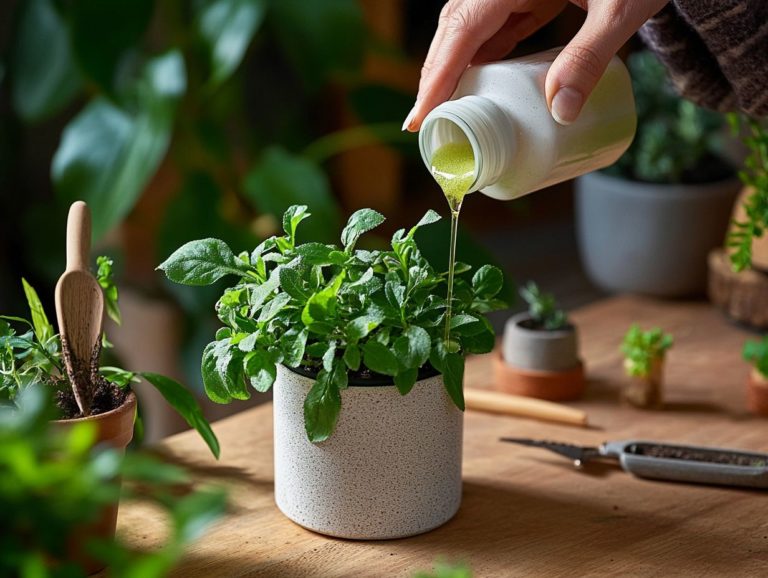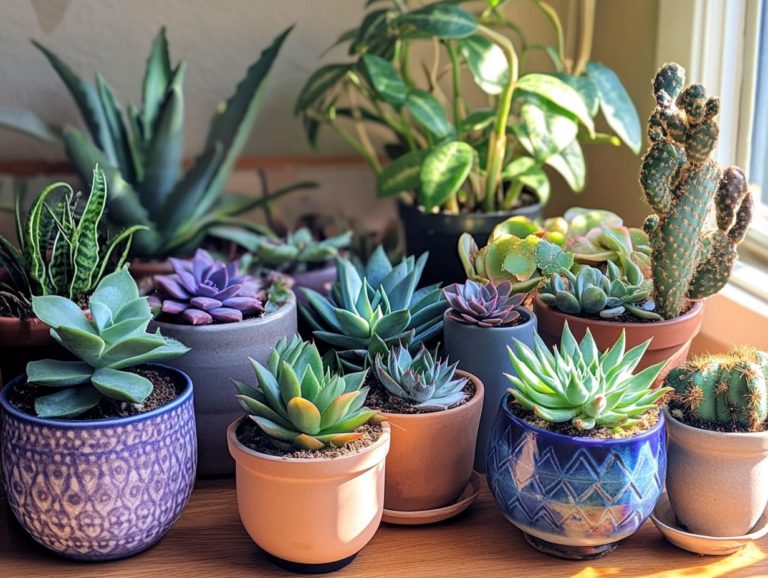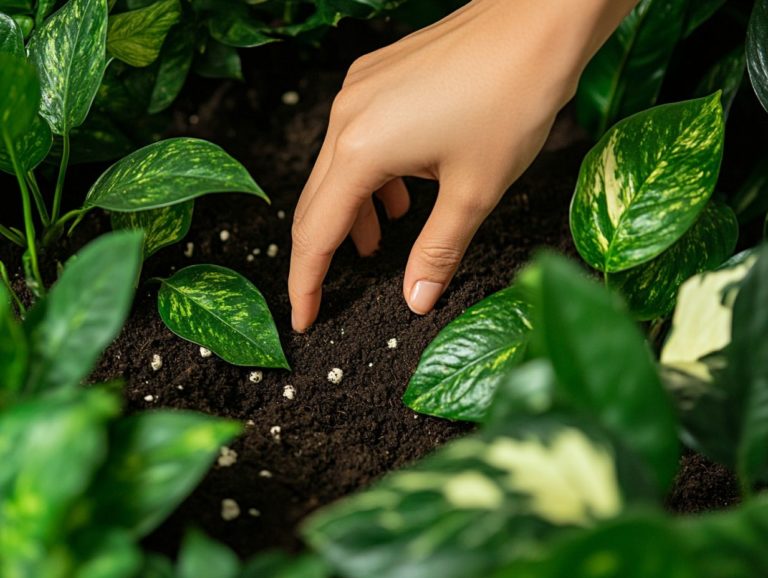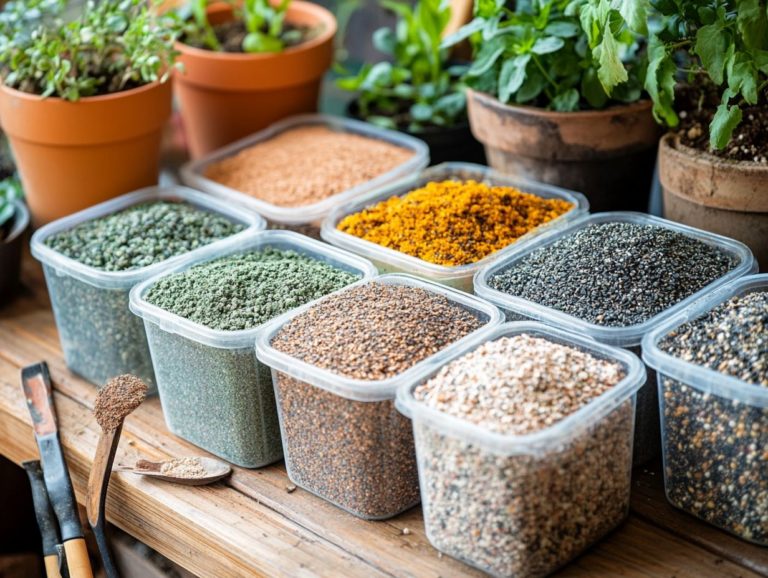The Best Potting Mixes for Small Indoor Plants
Choosing the right potting mix is crucial for the health and growth of your small indoor plants. A suitable potting mix retains moisture, ensures drainage, and provides nutrients.
With so many options available, navigating the differences between organic, synthetic, and soilless mixes can easily feel overwhelming. This guide will walk you through the various types of potting mixes, their benefits, and even how to create your own concoction.
You ll also discover top brands and key ingredients to seek out, ensuring your indoor oasis flourishes. Get ready to discover the best potting mixes for your plants!
Contents
- Key Takeaways:
- 1. Choosing the Right Potting Mix for Indoor Plants
- 2. Types of Potting Mixes
- 3. Benefits of Using the Right Potting Mix for Small Indoor Plants
- 4. Organic Potting Mixes
- 5. Synthetic Potting Mixes
- 6. Soilless Mixes
- 7. How to Make Your Own Potting Mix
- 8. Factors to Consider When Buying Potting Mix
- 9. Best Potting Mixes for Small Indoor Plants
- 10. Top Brands for Potting Mixes
- What Are the Key Ingredients to Look for in a Potting Mix?
- How Often Should You Repot Your Indoor Plants?
- What Are the Signs That Your Indoor Plant Needs Repotting?
- How Can You Determine the Right Pot Size for Your Indoor Plant?
- What Are Some Tips for Properly Using Potting Mix for Small Indoor Plants?
- What Are Some Common Mistakes to Avoid When Choosing and Using Potting Mix?
- Frequently Asked Questions
- What are the best potting mixes for small indoor plants?
- What is the importance of using the right potting mix for small indoor plants?
- Can I make my own potting soil for small indoor plants?
- Are there any specific soil mixes for certain types of indoor plants?
- How often should I change the potting soil for my indoor plants?
- Can I reuse potting soil for my indoor plants?
Key Takeaways:

- Choosing the right potting mix is crucial for the health and growth of small indoor plants.
- Organic, synthetic, and soilless potting mixes all have unique benefits for small indoor plants.
- When buying potting mix, consider factors such as drainage, nutrients, and pH levels to ensure the best results for your plants.
1. Choosing the Right Potting Mix for Indoor Plants
Choosing the right potting mix for your indoor plants is absolutely crucial for their health and growth. Suitable soil mixes support moisture retention, drainage, and nutrient availability, all tailored to meet the unique needs of your plants whether they re tropical beauties, resilient succulents, or popular houseplants like Monstera and Fiddle Leaf Fig.
Several key factors play a significant role in selecting the ideal potting mix. The soil’s texture and composition can dramatically impact its moisture retention and drainage capabilities.
For instance, tropical plants flourish in a mix full of natural materials that retains moisture while allowing for adequate airflow, which is essential for preventing root rot. Succulents thrive in well-draining soil, often enhanced with perlite or sand to keep water retention at bay.
By grasping these nuances in plant care, you not only make an informed choice about the right mix but also support the growth and vitality of your green companions. This shields them from the common pitfalls associated with improper watering and unsuitable soil conditions.
2. Types of Potting Mixes
Understanding the various types of potting mixes available is crucial for your success in indoor gardening. Each option be it organic potting, synthetic mixes, or soilless blends comes with its own set of unique advantages and challenges, tailored to meet the specific nutrient needs of your indoor plants.
For example, organic potting mixes, loaded with natural materials like compost and peat, excel in moisture retention. This makes them perfect for tropical plants that thrive in humid environments.
Synthetic potting mixes often incorporate water-retaining crystals along with nutrients, promoting rapid growth while ensuring proper aeration. This is especially beneficial for flowering plants.
Then there are soilless blends, featuring materials such as coconut coir and perlite. These mixes shine in preventing root rot, making them ideal for cacti and succulents that require excellent drainage and lower moisture levels.
By thoughtfully selecting the right potting mix, you can create the perfect conditions for your green companions to flourish.
3. Benefits of Using the Right Potting Mix for Small Indoor Plants
Using the right potting mix for your small indoor plants is essential. It not only promotes healthy roots and optimal growth but also ensures effective moisture retention, soil aeration, and nutrient availability.
These factors are vital for the thriving life of delicate species like cacti and succulents. You can easily meet these specific needs with a well-formulated potting mix that strikes the perfect balance between drainage and moisture-holding capacity.
For example, a blend that includes perlite or vermiculite will enhance aeration and prevent the soil from becoming too compact crucial for the root systems of miniature plants, such as jade plants.
Opting for a mix enriched with organic matter introduces beneficial microorganisms that aid in nutrient uptake. It’s advisable to select mixes specially designed for your particular plant type to maximize growth potential, ensuring these charming indoor varieties truly flourish.
Don t wait your plants need this! Start planting today and give your indoor plants the best chance to thrive!
4. Organic Potting Mixes
Organic potting mixes, enriched with ingredients like earthworm castings, coco coir, and peat moss, offer you a sustainable solution for your indoor gardening endeavors.
These mixes not only enhance soil that has plenty of nutrients but also support robust plant growth and resilience against diseases.
These components work together well to create an optimal environment for your plants’ roots. Earthworm castings serve as a powerhouse of nutrients, promoting healthier development and improving soil aeration.
Meanwhile, coco coir excels in moisture retention, ensuring your plants receive consistent hydration without the risk of over-saturation. Peat moss enhances soil structure, allowing for better drainage while also providing essential organic matter.
Together, these elements contribute to a balanced ecosystem and empower your plants to thrive while minimizing the need for synthetic fertilizers. With this approach, your garden can thrive, becoming healthier and more productive than ever!
5. Synthetic Potting Mixes
Synthetic potting mixes, often crafted from commercial soils and enriched with soil amendments like perlite (a lightweight material that helps with drainage) and vermiculite, offer you a controlled environment ideal for nurturing growth, particularly in situations that demand precise moisture retention and soil aeration.
These mixes also usually contain a blend of peat moss, coconut coir, and various fertilizers, creating a balanced nutrient profile that caters to a diverse array of plants. Their specialized composition allows them to excel in scenarios where rapid drainage is essential or when working with plants susceptible to root rot.
While the predictability of synthetic mixes can be a significant advantage, it s worth noting that they might lack some of the beneficial microbial communities you d find in organic alternatives.
In contexts such as container gardening or urban environments where soil quality is not up to par, synthetic options often prove more effective, delivering the reliability that many growers actively seek.
6. Soilless Mixes
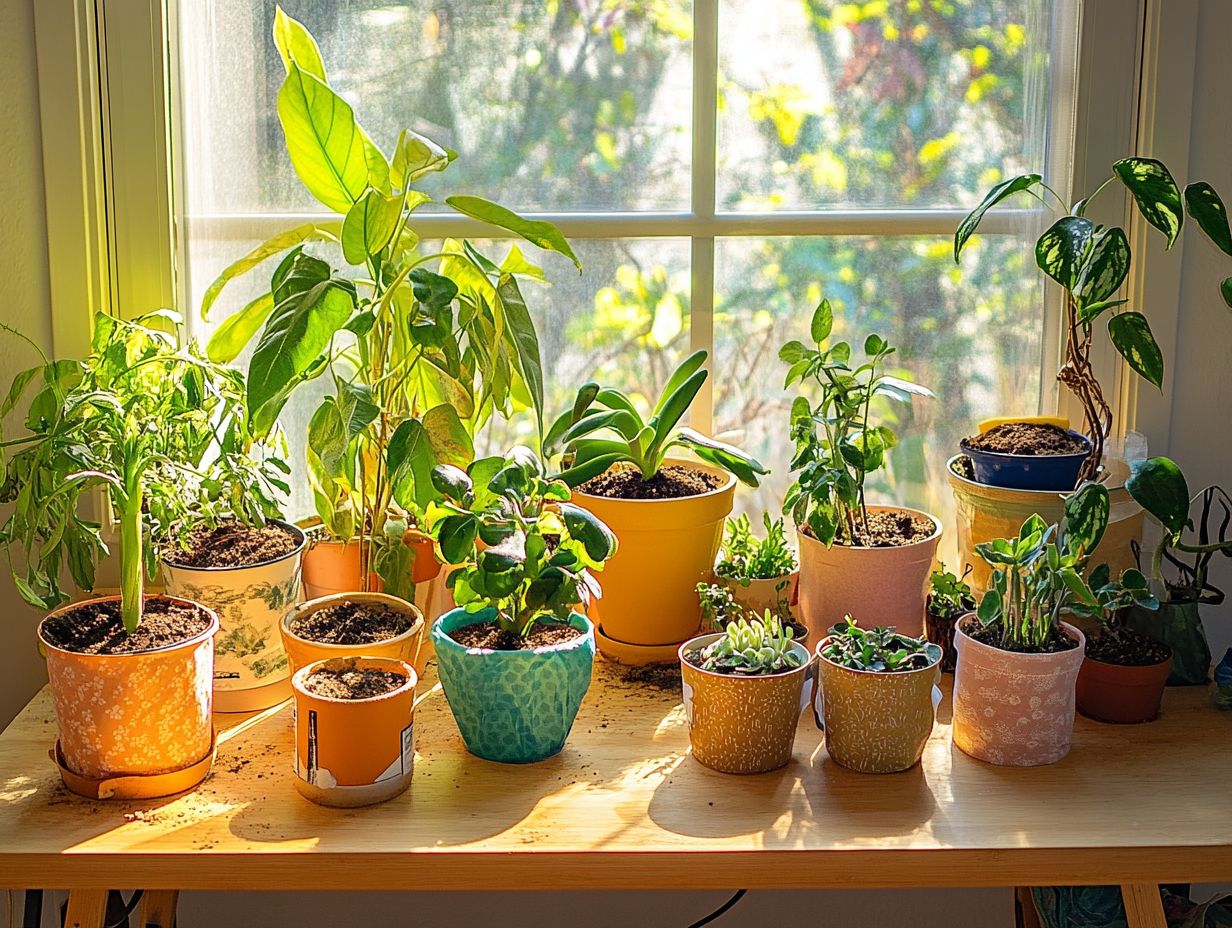
Soilless mixes, which expertly combine materials like coco coir, perlite, and vermiculite, present an innovative solution for you as an indoor gardener aiming to optimize moisture retention and drainage.
These blends are particularly well-suited for a variety of indoor plants, including tropical species and succulents. By using these mixes, you significantly enhance aeration, allowing plant roots to breathe more effectively, which can lead to robust growth.
For example, when you choose a soilless mix for orchids, you help prevent root rot by ensuring ample drainage while retaining just the right amount of moisture.
Similarly, succulents flourish in these mixes, as they thrive in well-aerated environments that minimize the risk of overwatering. If you re cultivating seedling trays, opting for a soilless medium can also boost root development and overall seedling vigor by striking the perfect balance of air and moisture.
7. How to Make Your Own Potting Mix
Creating your own potting mix offers a unique opportunity for customization, perfectly aligned with the specific needs of your indoor plants.
Typically, this involves a thoughtful blend of ingredients such as peat moss, coco coir, perlite, and nutrient-rich amendments like earthworm castings to enhance both nutrient retention and aeration.
By understanding the distinct requirements of various plant types, you can adjust the ratios to suit their needs. For instance, a basic recipe might look like this:
- 40% peat moss
- 30% coco coir
- 30% perlite
This combination serves as an all-purpose mix, providing excellent moisture retention while ensuring adequate drainage.
If you re nurturing succulents or cacti, consider increasing the perlite ratio to 50% and reducing the peat moss to 25% to help prevent overwatering. On the other hand, tropical plants may thrive by incorporating a bit of compost to enrich the organic matter.
Regularly assessing the moisture levels and observing how your plants respond will empower you to fine-tune your potting mix further, ensuring your indoor garden flourishes beautifully.
Start experimenting with your own potting mix today and watch your plants flourish!
8. Factors to Consider When Buying Potting Mix
Look for the right ingredients to keep your indoor plants happy and healthy. Pay attention to specific components, nutrient requirements, soil characteristics, and moisture retention capabilities, as these elements greatly influence plant health and growth.
Consider the brand’s reputation when selecting your potting mix. Trustworthy brands prioritize quality to help your plants thrive. Additionally, think about where the ingredients are sourced; choosing organic components boosts your plants’ health and supports the planet!
It’s crucial to determine how compatible the mix is with your specific plant types. Some plants grow well in coarser mixes, while others prefer finer soils. Before you buy, check for certifications and read reviews. A close examination of the texture of the mix will provide you with valuable insight into its quality and effectiveness.
9. Best Potting Mixes for Small Indoor Plants
Identifying the best potting mixes for your small indoor plants is key to promoting healthy growth. Organic potting mixes or specialized succulent blends can dramatically improve growing conditions for delicate varieties like cacti and tropical plants.
With the right mix, these plants can grow well, showcasing lush foliage and vibrant colors that brighten your home. A high-quality organic potting mix, filled with compost and balanced nutrients, provides a perfect environment for houseplants, ensuring they retain adequate moisture while promoting excellent drainage.
Many gardeners recommend using orchid mixes for better growth, typically made with pine bark and perlite. This combination ensures essential air circulation around the roots. For those curious about the best options, understanding what soil is best for indoor plants is crucial. Garden enthusiasts often report a noticeable boost in growth and blooming rates after switching to these specialized blends, highlighting their effectiveness in creating an optimal habitat for your small indoor flora.
10. Top Brands for Potting Mixes
Several top brands provide high-quality potting mixes tailored to your indoor gardening needs. Standout names include:
- FoxFarm Ocean Forest
- Miracle-Gro
- Espoma Organic
- K-IT Products
Each brand offers unique formulations designed to ensure optimal plant health. These brands meticulously craft their products with specific ingredients that enhance drainage, retain moisture, and deliver essential nutrients.
For instance, FoxFarm Ocean Forest is favored for its rich compost and organic materials, including earthworm castings, guaranteeing robust growth for a variety of plants. Miracle-Gro, known for its scientific approach, offers nutrient formulas that cater specifically to the needs of flowering plants, helping them flourish rapidly.
Espoma Organic emphasizes sustainability, providing potting mixes that not only support thriving plants but also promote environmental well-being. Pick a top brand, and watch your plants thrive; the right mix can significantly influence your plants’ vigor and longevity while meeting their nutrient needs.
What Are the Key Ingredients to Look for in a Potting Mix?
Understanding key ingredients helps you choose the right mix. Look for components like peat moss, coco coir, perlite, and vital soil nutrients such as vermiculite (a mineral that helps with water retention) and sphagnum moss to achieve the perfect balance of moisture retention, aeration, and nutrient supply for your indoor plants.
These elements create optimal growing conditions. For example, peat moss is famous for its impressive water retention, keeping the soil pleasantly moist without getting too wet. Coco coir not only holds moisture but also encourages robust root development thanks to its fibrous texture.
Perlite, a lightweight volcanic glass, ensures good aeration, preventing soil compaction and allowing roots to breathe. By crafting a well-structured potting mix—a harmonious blend of 40% peat moss, 30% coco coir, and 30% perlite, along with some bark chips—you can significantly elevate the growth and health of your indoor plants. Consider incorporating top soil amendments for healthy indoor plants for even better results.
How Often Should You Repot Your Indoor Plants?

Repotting your indoor plants is a crucial practice that helps your plants grow better. Ideally, consider repotting every 12 to 18 months or whenever you see signs that your plant is outgrowing its current pot and soil.
Look for key indicators, such as root crowding, where roots start emerging from the drainage holes or wrapping around the pot’s interior. Another critical sign is the degradation of the soil; if it becomes compacted or can’t retain moisture, it s a clear signal that repotting is needed.
Once you recognize these conditions, act to help your plant. Choose a new potting mix that suits your plant type, ensuring it has the right balance of drainage and nutrients. Adding organic matter, like earthworm castings, can further enhance soil quality. For optimal growth, consider using some of the top fertilizers for thriving indoor plants, creating a thriving environment for your plants.
What Are the Signs That Your Indoor Plant Needs Repotting?
Recognizing the signs that your indoor plant needs repotting is essential for its health. Look for symptoms like root rot, slow growth, and visibly crowded roots within the potting mix.
Yellowing leaves or stunted growth are signs that your plant needs more space. Water pooling on the surface instead of being absorbed can indicate compacted soil, issues with moisture retention, or overcrowded roots.
To prevent root rot, ensure your pots have adequate drainage holes and use a well-aerated potting mix that includes chunky aroid components.
Regularly check moisture levels before watering to maintain a healthy balance, keeping your plants thriving and minimizing potential issues.
How Can You Determine the Right Pot Size for Your Indoor Plant?
Determining the right pot size for your indoor plant is crucial for healthy roots and optimal growth. You ll want a pot that is 1-2 inches wider in diameter than the current one; this helps with proper drainage and soil aeration.
The right pot size can significantly influence your plant’s ability to develop strong roots. Seedlings need smaller pots to encourage compact root systems, while mature plants thrive in larger containers that allow for expansion.
Choose pots made from the right materials and ensure they drain well to keep your plants happy! Consider pots with drainage holes and add materials like gravel or bark chips at the bottom to enhance water management.
What Are Some Tips for Properly Using Potting Mix for Small Indoor Plants?
Using potting mix effectively for your small indoor plants involves several key tips that improve moisture retention and create optimal growth conditions.
Creating the right environment is vital for your plants’ success. Adjust your watering habits to meet each plant’s specific needs and avoid the common pitfall of overwatering. Let the top inch of potting mix dry out before you water again, especially for succulents.
Mix different potting mediums to improve drainage and aeration, which is crucial for healthy plant care.
Regularly check your soil health and make changes as needed to ensure that nutrients remain accessible, fostering vibrant growth and robust development for your plants.
What Are Some Common Mistakes to Avoid When Choosing and Using Potting Mix?
Choosing the right potting mix is crucial for your plants. Using poor-quality soil or skipping drainage can lead to root rot and stunted growth.
Pay close attention to your plants’ specific needs, particularly their pH balance and soil texture. These factors significantly influence how well your plants absorb nutrients.
Overwatering can happen if you use compacted mixes, which suffocate roots. Remember, not all potting mixes are created equal; some contain additives or compacted soil that could harm delicate species.
By carefully checking each ingredient, including organic matter like earthworm castings and moisture retention properties, you can create an environment that promotes healthy growth and vibrant foliage.
Frequently Asked Questions
What are the best potting mixes for small indoor plants?

Good options include peat-based mixes, coco coir, and blends of peat, perlite, and vermiculite.
What is the importance of using the right potting mix for small indoor plants?
The right potting mix provides essential plant nutrients, proper drainage, and aeration for plants to thrive in a confined space.
Can I make my own potting soil for small indoor plants?
Yes, you can create your own potting mix by combining equal parts of peat, perlite, and vermiculite. This blend offers a balance of nutrients, moisture retention, and aeration.
Are there any specific soil mixes for certain types of indoor plants?
Yes, some small indoor plants may need specific mixes. For instance, succulents and cacti thrive in well-draining potting mixes, while orchids prefer a mix with high moisture retention.
How often should I change the potting soil for my indoor plants?
Don’t wait! Change your potting mix every 1-2 years for the best results. This keeps nutrients fresh and improves drainage.
Can I reuse potting soil for my indoor plants?
Yes, you can reuse potting mix by refreshing it with new nutrients and removing debris. However, it s best to replace the mix entirely every 1-2 years to ensure optimal plant health.


